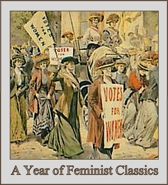Reviewed by Liesl
Published: 2004
It's about: (Hi, Amazon - thanks, Amazon) Marji tells of her life in Iran from the age of 10, when the Islamic
revolution of 1979 reintroduced a religious state, through the age of 14
when the Iran-Iraq war forced her parents to send her to Europe for
safety. This story, told in graphic format with simple, but expressive,
black-and-white illustrations, combines the normal rebelliousness of an
intelligent adolescent with the horrors of war and totalitarianism.
Marji's parents, especially her freethinking mother, modeled a strong
belief in freedom and equality, while her French education gave her a
strong faith in God. Her Marxist-inclined family initially favored the
overthrow of the Shah, but soon realized that the new regime was more
restrictive and unfair than the last. The girl's independence, which
made her parents both proud and fearful, caused them to send her to
Austria. With bold lines and deceptively uncomplicated scenes, Satrapi
conveys her story.
I thought: If you want to learn about a different culture - and I mean REALLY learn, not just look at the highlights of history - don't read something written by someone who has studied it but never lived it. Read something by someone who knows exactly what they're talking about and why things are the way they are. Persepolis is the perfect type of book for that. It is able to portray both the good and the bad, to show more about Iran than just what is shown on the news.
I loved reading about Marji. Her character was lively and interesting: sometimes rebellious, other times religious, sometimes acting on blind faith, but always full of love for her parents and friends. I liked watching her be rebellious and I liked all the conversations she had with God when she was about 10. Marji had a very unique perspective of life, and Satrapi was able to capture the childlike perspective very well without weighing it down with sentimentality.
The art style is a very simple style, which sometimes had me confusing the characters. Still, it was told very effectively and Satrapi inserted some humor into the illustrations as well.
This book was not easy for me to read. There were several times where I had to put the book down and just sit and try not to be to distraught, or maybe get up and do something else. It was a sad and horrifying book, what with her depictions of torture and violence, but I was determined to read about the Islamic revolution in Iran and because of Marjane's statement at the beginning of the book, I wanted to read it for her. So despite the difficulty of it, I was able to finish the book and I don't regret it for a minute.
Verdict: Stick it on the shelf.
Reading Recommendations: I think it is beneficial for anyone to read this, but I also caution the highly sensitive, being sensitive myself.
Warnings: Disturbing depictions of torture, swearing, violence, mentions of rape
Favorite excerpts:
What I'm reading next: Still The Code of the Woosters by P.G. Wodehouse - almost done
Tuesday, September 20, 2011
Review: Persepolis: The Story of a Childhood by Marjane Satrapi
2011-09-20T12:54:00-04:00
Liesl
Creative Non-Fiction|Graphic Novel|Liesl|On the Shelf|









